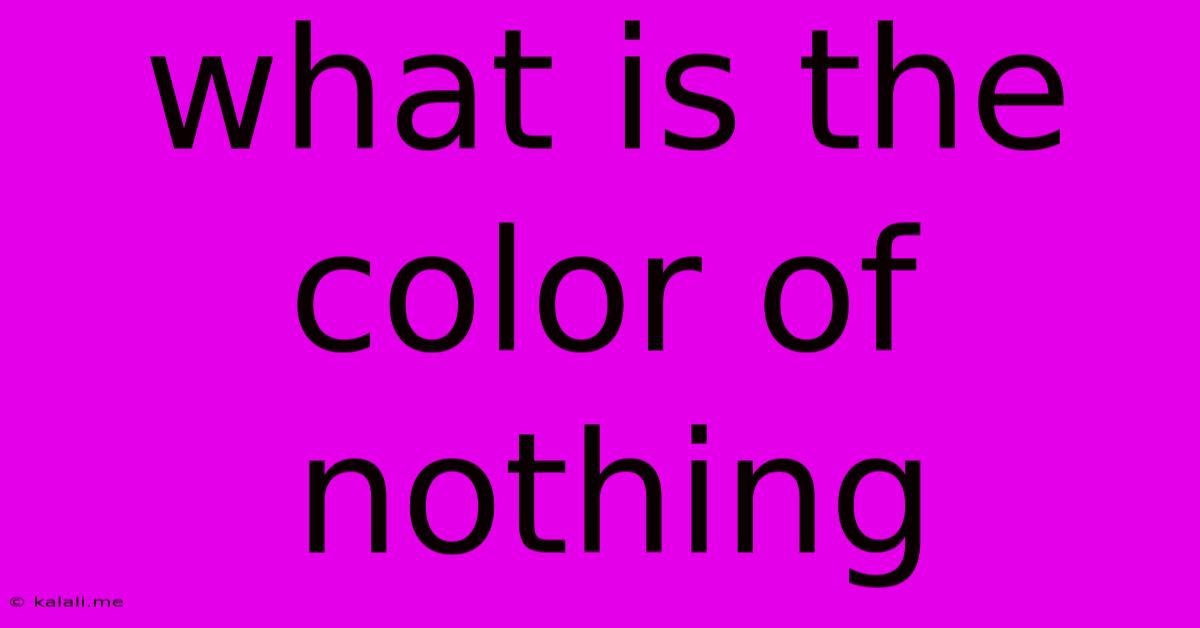What Is The Color Of Nothing
Kalali
May 23, 2025 · 3 min read

Table of Contents
What is the Color of Nothing? A Philosophical and Scientific Exploration
The question, "What is the color of nothing?" seems deceptively simple. It's a playful thought experiment that delves into the nature of perception, reality, and the very limits of our understanding. While there's no single definitive answer, exploring this question reveals fascinating insights into physics, philosophy, and the human experience. This article will explore different perspectives on this intriguing query, from the scientific understanding of absence of light to philosophical interpretations of nothingness.
The Absence of Light: A Scientific Perspective
Scientifically speaking, "nothing" in a visual context refers to the absence of light. When light is absent, our eyes perceive black. However, this "black" isn't necessarily the color of nothing itself. Instead, it's our brain's interpretation of a lack of visual stimulation. True nothingness, a complete void devoid of even spacetime, is beyond our current scientific ability to comprehend, let alone assign a color to. Consider the concept of a true vacuum – even this is not entirely empty, containing virtual particles constantly flickering in and out of existence. Therefore, even a seemingly empty space has some level of physical presence.
Beyond the Visual Spectrum: Exploring Other Sensory Inputs
Our understanding of "nothing" is heavily reliant on our visual perception. But what about other senses? Can we consider the "sound of nothing," the "smell of nothing," or the "taste of nothing"? These concepts highlight the limitations of assigning a single, universal characteristic, like color, to the absence of something. Each sensory modality experiences "nothing" differently. The "silence" of nothing, for example, could be described as the absence of sound waves, not a specific auditory experience itself.
Philosophical Interpretations of Nothingness
Philosophers have grappled with the concept of nothingness for centuries. The very idea of "nothing" challenges fundamental assumptions about existence and reality. Some philosophical schools suggest that true nothingness is inconceivable, an impossible state to even comprehend. Others argue that nothingness is a necessary concept to understand existence; the void from which everything arises. Defining "nothing" becomes a complex exercise in ontology, the study of being, and metaphysics.
The Color of Nothing in Art and Imagination
Artists have often used black, or the absence of color, to represent nothingness, emptiness, or the void. However, the artistic interpretation is not a scientific definition. Black itself is a visual phenomenon, a specific wavelength range of light that is absorbed rather than reflected. Moreover, many artworks use the concept of "nothingness" to evoke emotions and ideas far beyond simply assigning a color to it. The absence of a concrete image or form can be powerfully suggestive.
Conclusion: The Ever-Elusive Color
The question of the color of nothing remains a fascinating thought experiment. While the simplest scientific answer points to black as the representation of the absence of light, the philosophical and artistic dimensions greatly expand our understanding. Ultimately, the color of nothing depends on the lens through which we view it, and perhaps, true nothingness transcends the limitations of human sensory perception and language entirely. The ambiguity of the question continues to provoke exploration and invites us to consider the nature of reality and the bounds of our comprehension.
Latest Posts
Latest Posts
-
How To Wire 3 Way Switch
May 24, 2025
-
How To Find The Perimeter Of A Triangle
May 24, 2025
-
How Many Ounces In A Box Of Powdered Sugar
May 24, 2025
-
How To Find Perimeter Of A Triangle
May 24, 2025
-
What Gauge Wire For 20 Amp
May 24, 2025
Related Post
Thank you for visiting our website which covers about What Is The Color Of Nothing . We hope the information provided has been useful to you. Feel free to contact us if you have any questions or need further assistance. See you next time and don't miss to bookmark.